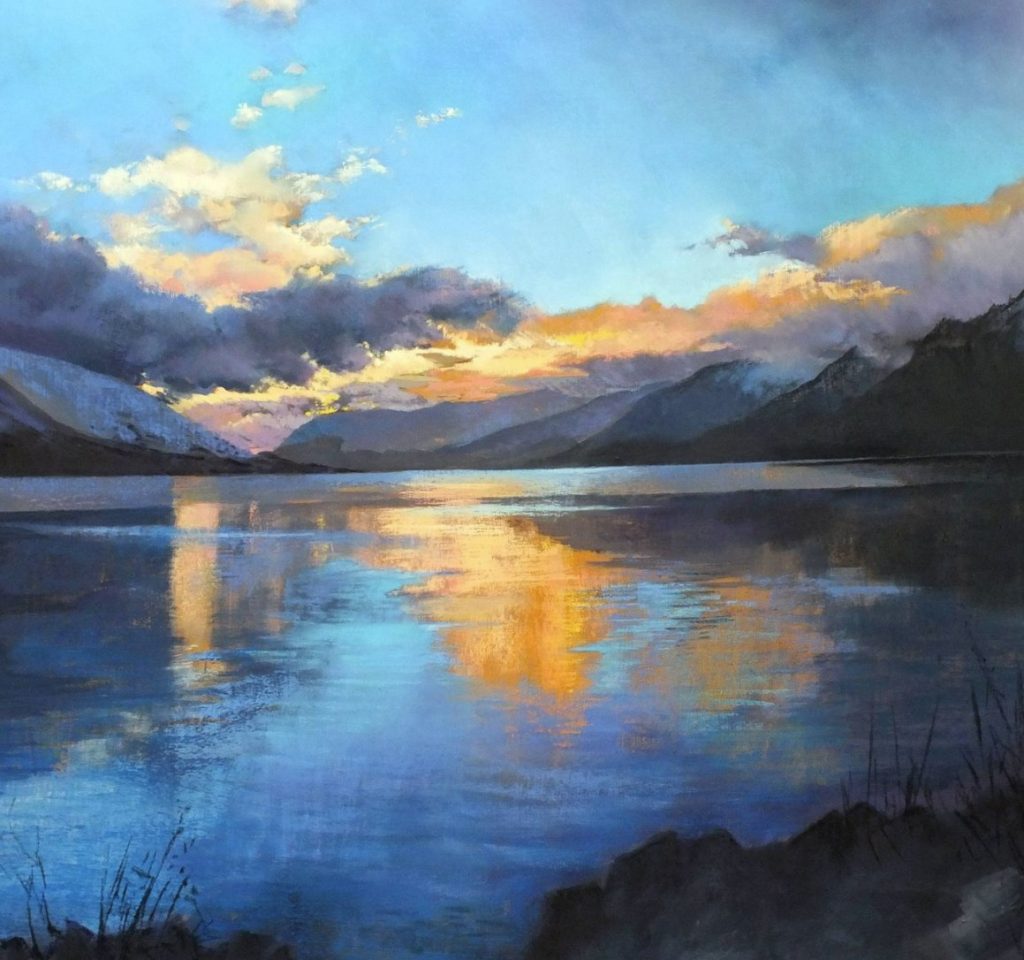Oil pastels, with their vibrant hues and smooth texture, beckon artists to capture the grandeur and intimacy of landscapes. Unlike traditional paints, they offer a delightful immediacy, allowing you to translate the rolling hills, shimmering lakes, or fiery sunsets directly onto your canvas. This guide delves into four key techniques to unlock the potential of oil pastels and transform them into tools for creating stunning landscapes.
Part 1: Building the Foundation – Layering and Color

Establishing Depth: Separating Foreground, Midground, Background
Creating a sense of depth is crucial for captivating landscapes. Begin by dividing your workspace into three sections: foreground, midground, and background. Utilize darker, cooler colors for the background, representing distance. As you move forward, introduce progressively lighter and warmer tones for the midground and foreground elements. This creates a natural illusion of depth and receding space, drawing the viewer into your artwork.
Color Choices: Reflecting Mood and Season
Oil pastels, with their extensive range of colors, provide artists with the means to authentically capture the essence of any landscape while evoking specific moods and atmospheres. When aiming to depict a vibrant summer scene, incorporating bright greens, yellows, and blues can effectively convey the warmth, energy, and vividness of the season. Conversely, when seeking to portray a tranquil autumn landscape, utilizing warm oranges, reds, and yellows can evoke the sense of calm and nostalgia associated with the season. Additionally, incorporating cooler shades such as blues and purples is essential for adding shadows and depth within each section of the artwork, contributing to a heightened sense of realism and visual appeal. By skillfully blending and layering these colors, artists can artfully convey the emotions and atmosphere of the landscape they are portraying, enriching the overall visual and emotional impact of their artwork.

Part 2: Creating Texture and Dimension
The Power of Strokes: Direction and Variation
The direction and variation in which you apply your strokes play a crucial role in shaping the texture and overall feel of your landscape artwork. When using oil pastels to create a landscape, it’s essential to consider how the strokes can convey specific textures and aspects of the scene. Employ short, choppy strokes to depict rough textures such as tree bark or jagged mountains, effectively conveying a sense of ruggedness and depth in these elements. On the other hand, using long, sweeping strokes is more suitable for portraying elements like rolling hills or a serene sky, imparting a sense of openness and tranquility. Experimenting with the pressure applied while using oil pastels is also key.
Layering and Scumbling: Building Realistic Textures
Don’t shy away from layering your oil pastels! Apply thin layers of different colors to build a more realistic representation of natural textures. For instance, layer greens and blues to create a textured forest floor, or use browns and yellows with light pressure to depict sun-drenched rocks. Scumbling, a technique where you lightly apply a color over another, can add subtle texture and depth to your landscape, creating a more nuanced and realistic representation.

Part 3: Enhancing the Mood: Techniques for Atmosphere
Softening the Edges: Blending for Depth and Atmosphere
Oil pastels are highly adept at blending, offering artists the ability to create captivating atmospheric effects in their landscapes. By using techniques such as utilizing their fingers, blending stumps, or a cotton swab dipped in solvent (with caution), artists can expertly soften the edges between colors. This blending process results in a hazy effect, effectively mimicking the appearance of distance or various atmospheric conditions such as fog or smoke. In doing so, artists can infuse their artwork with a sense of mood and mystery, evoking a captivating and enigmatic ambiance. This technique not only adds depth and dimension to the landscape but also enhances the emotional resonance of the piece. Through skillful blending and manipulation of colors, artists can effectively convey a sense of distance, mood, and atmosphere in their landscapes, elevating the overall visual and emotive impact of the artwork.
Selective Detail: Balancing Focus and Atmosphere
Capturing the overall atmosphere of a landscape is essential, but it’s equally important to infuse the artwork with details that vivify the scene. Utilizing the tip of an oil pastel or a blending tool with minimal pressure can be instrumental in defining elements such as tree branches, wildflowers, or ripples in a stream, infusing the landscape with a sense of vitality and realism. It’s crucial to strike a delicate balance between detailed areas and softer, blended sections to create a cohesive and visually engaging landscape. These intricately defined details can contribute to the overall mood and appeal of the artwork, captivating the viewer’s attention and inviting them to explore the intricacies of the scene. By skillfully incorporating these finer details, artists can bring their landscapes to life, eliciting an emotional and visual response that resonates with the viewer.

Part 4: Experimentation and Practice: Honing Your Landscape Skills
Embrace the Unexpected: Exploring Color and Technique
Oil pastels are celebrated for their remarkable versatility, offering artists the freedom to explore unexpected color combinations and innovative techniques. Embracing experimentation is key and artists should not hesitate to try unconventional tools for blending, or even consider applying water or solvent washes over their oil pastels to achieve unique and captivating effects. By indulging in such adventurous and inventive approaches, artists can uncover the distinct potential of this medium, leading to the development of a personal and distinctive artistic style. It’s through these creative explorations that artists can find new ways to express their vision, ultimately enhancing their skills and broadening their artistic horizons. By pushing the boundaries of traditional usage and embracing experimentation, artists can unlock the full potential of oil pastels, leading to the creation of truly original and captivating artwork.
Practice Makes Perfect: Capturing the Essence of Nature

Creating captivating landscapes with oil pastels takes dedication and practice. Start with small studies focusing on specific elements like trees, mountains, or skies. As you gain confidence, attempt larger landscapes, gradually incorporating all the techniques covered in this guide. Remember, the more you practice, the better you’ll understand how to translate the essence of nature onto your canvas with oil pastels, capturing the beauty and drama of the natural world.
By mastering these techniques and fostering a spirit of exploration, you’ll unlock the power of oil pastels to create stunning landscapes. Let your creativity flow, and embark on your own artistic journey!





